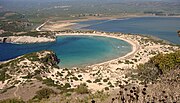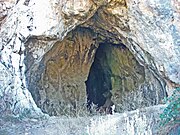| Revision as of 12:44, 20 September 2010 editFæ (talk | contribs)Extended confirmed users, Rollbackers83,148 edits image← Previous edit | Revision as of 12:53, 20 September 2010 edit undoFæ (talk | contribs)Extended confirmed users, Rollbackers83,148 edits coordNext edit → | ||
| Line 1: | Line 1: | ||
| ] | ]{{coord|36.963973399776386| 21.659637093544006|display=title}} | ||
| '''Voidokilia Beach''' is a popular beach in ] in the Mediterranean area. In the shape of the Greek letter omega (Ω), its sand forms a semicircle which the beach is formed around. The beach has been named "A Place of Particular Natural Beauty" and protected by natura 2000. | '''Voidokilia Beach''' is a popular beach in ] in the Mediterranean area. In the shape of the Greek letter omega (Ω), its sand forms a semicircle which the beach is formed around. The beach has been named "A Place of Particular Natural Beauty" and protected by natura 2000. | ||
Revision as of 12:53, 20 September 2010

Voidokilia Beach is a popular beach in Messinia in the Mediterranean area. In the shape of the Greek letter omega (Ω), its sand forms a semicircle which the beach is formed around. The beach has been named "A Place of Particular Natural Beauty" and protected by natura 2000.
History and myth
Above the beach is Nestor's Cave and above this are the ruins of a 13th century Frankish castle ("Palaiokastro"). Overlooking the beach at the north end is the tomb of Nestor's son, Thrasimidis.
The beach is presumed to be Homer's "sandy Pylos" where Telemachus was welcomed by King Nestor when searching for his father, Odysseus. According to myth, Nestor's Cave is where Hermes hid the cattle stolen from Apollo.
Location
A hiking route begins from Voidokoilia. The climb towards Nestor's Cave begins at the south-west end of the beach, while after the cave the route continues towards Palaiokastro. Voidokilia is next to Petrohori in Messinia, Greece. Yalova's aquatic habitat, being an important stop for a variety of migratory birds, has been declared the southernmost Habitat of National Importance in the Balkans. It is considered a protected area hosting 258 species of birds out of which the 79 are included in the "Red Book" (species under threat of extinction).
Gallery
-
 View from Nestor's Cave looking down to the beach and the lagoon.
View from Nestor's Cave looking down to the beach and the lagoon.
-
 View from Thrasimidis' tomb.
View from Thrasimidis' tomb.
-
 Entrance to Nestor's cave.
Entrance to Nestor's cave.
-
 Naturism on the south end of the beach.
Naturism on the south end of the beach.
Footnotes
- Bostock, Andrew (2010), Greece: The Peloponnese, Bradt Travel Guides, p. 158, ISBN 9781841623078
- Willett, David; Bain, Carolyn; Clark, Michael; Hannigan, Des (2004), Greece (6 ed.), Lonely Planet, p. 189, ISBN 9781740594707
- "Pylos M. / Excursion from Voidokiliabay to Palaiokastro hill". En.agrotravel.gr. 2008-07-14. Retrieved 2010-09-20.
External links
Category: